Adhemarius gannascus gannascus
|
|
Updated as per More, Kitching and Cocucci's Hawkmoths of Argentina 2005, October, 2007
Updated as per http://www.pybio.org/SPHINGINAE.htm, October 2007
Updated as per
AN ANNOTATED CHECKLIST OF THE SPHINGIDAE OF BOLIVIA, October 2007
Updated as per http://biological-diversity.info/sphingidae.htm (Belize), November 2007
Updated as per Fauna Entomologica De Nicarauga, November 2007
Updated as per The Known Sphingidae of Costa Rica, November 2007
Updated as per personal communication with Vladimir Izersky (Junin Peru, October 21, 2008, 1050m), November 2008.
|
Adhemarius gannascus gannascus
ad-heh-MAHRR-ee-usmmgan-NAS-kus
(Stoll, 1790)
Sphinx
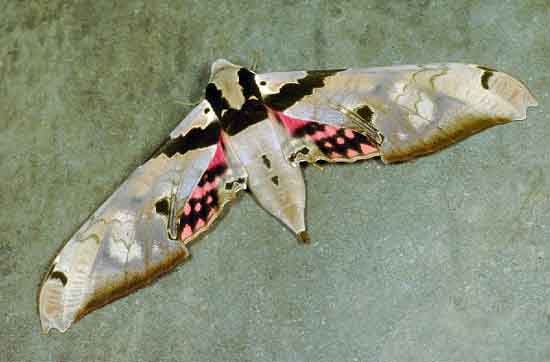
Adhemarius gannascus gannascus courtesy of Paolo Mazzei.
This site has been created by
Bill Oehlke at oehlkew@islandtelecom.com
Comments, suggestions and/or additional information are welcomed by Bill.
| TAXONOMY:
Superfamily: Sphingoidea, Dyar, 1902
Family: Sphingidae, Latreille, 1802
Subfamily: Sphinginae, Latreille, 1802
Tribe: Smerinthini, Grote & Robinson, 1865
Genus: Adhemarius, Oiticica, 1939
Species: gannascus gannascus, (Stoll, 1790) |
MIDI MUSIC
"What.A.Wonderful.World"
copyright C. Odenkirk
MIDI CITY
ON.OFF
<bgsound src="world.mid" LOOP=FOREVER>
|
DISTRIBUTION:
The Adhemarius gannascus gannascus
moth (wingspan: males: 92-112mm; females: 98-124 mm) flies in
Mexico;
Belize: Corozol, Orange Walk, Cayo, Stann Creek, Toledo;
Guatemala;
El Salvador;
Honduras;
Nicaragua: Madriz, Jinotega, Matagalpa, Chinandega,
Leon, Granada, Isla de Ometepe, Chontales, Zelaya, Rio San Juan;
Costa Rica: Guanacaste, Puntarenas, Lemon, Alajuela,
Carthage, Heredia, San Jose;
Panama;
Colombia;
Ecuador;
Peru: Junin;
Venezuela;
probably Guyana;
Suriname (specimen type locality);
probably French Guiana;
Bolivia: La Paz, Cochabamba, Santa Cruz;
Brazil;
northeastern Argentina: Corientes,
Missiones;
southern Paraguay: Presidente Hayes,
Concepcion, Amambay, San Pedro, Canindeyu, Cordillera, Caaguazu,
Alto Parana, Paraguari, Guaira, Caazapa, Itapua.
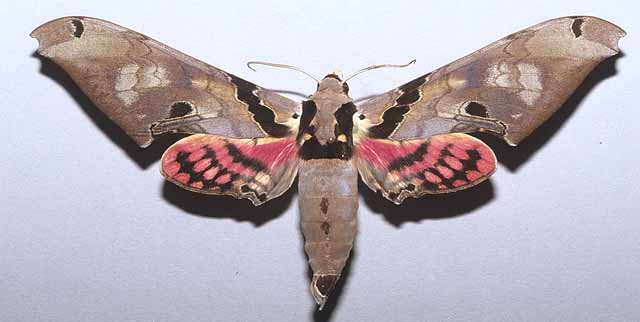
Adhemarius gannascus male
courtesy of Hubert Mayer copyright.
Ambulyx rostralis (Boisduval, 1870), Nicaragua, is same as gannascus gannascus
Ambulyx janus (Boisduval, 1870), Guatemala, is same as gannascus gannascus
Ambulyx daphne (Boisduval, [1875]), Brazil, is same as gannascus gannascus
Amplypterus f. connexa (Closs, 1911), Brazil, is same as gannascus gannascus
Amplypterus f. fulvescens (Closs, 1911), Mexico, is same as gannascus gannascus
Amplypterus f. grisescens (Closs, 1911), Colombia, is same as gannascus gannascus
Amplypterus f. rubra (Closs, 1911), Venezuela, is same as gannascus gannascus
Amplypterus f. acostalis (Closs, 1915), Mexico, is same as gannascus gannascus
Amplypterus f. interrupta (Closs, 1915), Mexico, is same as gannascus gannascus
Amplypterus f. mollis (Gehlen, 1928), Brazil, is same as gannascus gannascus
Amplypterus f. magicus (Gehlen, 1928), Colombia, is same as gannascus gannascus
Visit Adhemarius gannascus female, Rio Venado, Junin, Peru, courtesy
of Vladimir Izersky.
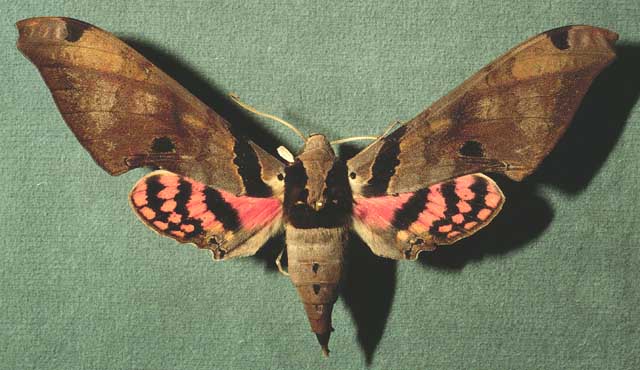
Adhemarius gannascus male, Costa Rica, courtesy of Dan Janzen.
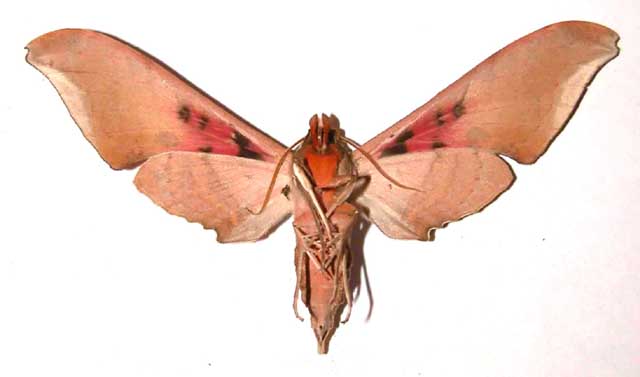
Adhemarius gannascus male underside, Costa Rica, courtesy of Dan janzen.
FLIGHT TIMES AND PREFERRED FOOD PLANTS:
Adhemarius
gannascus gannascus adults have been taken at lights in every
month of the year in Costa Rica.
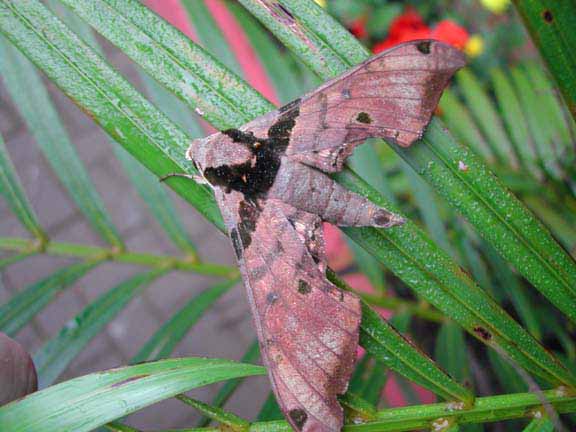
Adhemarius gannascus, Trapp Family Lodge, 1Km from
Monteverde Cloud Forest Preserve,
Costa Rica, June 6th 2005, courtesy of Mark Dennis via Andy Adcock.
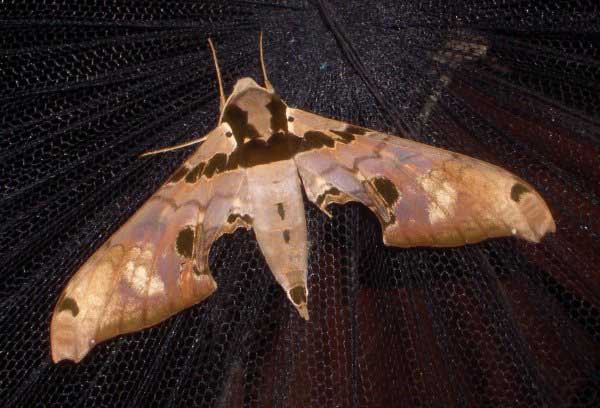
Adhemarius gannascus form interrupta ??, Arenal Lodge, Costa Rica,
September 22, 2008, courtesy of Tony James.
In Bolivia this species has been taken in August-September and December.
Adhemarius gannascus gannascus larvae feed upon Lauraceae (Rubiacaeae) and
Ocotea veraguensis, Persea povedae, Persea americana and
Nectandra salicina.
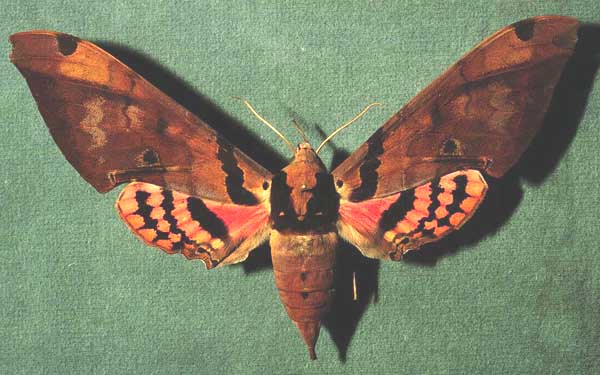
Adhemarius gannascus gannascus female courtesy of Dan Janzen.
ECLOSION, SCENTING AND MATING:
EGGS, LARVAE AND PUPAE:
Color morphs of larva courtesy of Dan Janzen.:
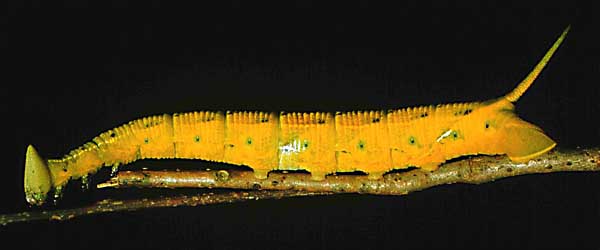
Adhemarius gannascus gannascus yellow morph.

Adhemarius gannascus gannascus green from (common).

Adhemarius gannascus gannascus pale green from with red dots.
Development from pupation to adult emergence is less than three weeks (sixteen to eighteen days). The pupa is dark chestnut, smooth and shiny.I suspect the larvae will pupate in dark buckets under layers of paper towels as opposed to more natural underground pupation. | 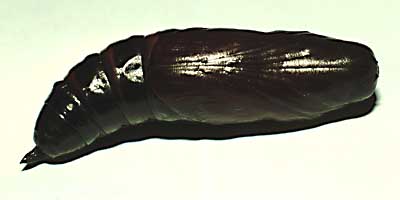 |
Larval Food Plants
Listed below are primary food plant(s) and alternate food plants. It is hoped that this
alphabetical listing followed by the common name of the foodplant will
prove useful. The list is not exhaustive. Experimenting with closely
related foodplants is worthwhile.
Nectandra salicina
Ocotea veraguensis.......
Persea americana
Persea povedae
|
Nectandra salicina
Ocotea veraguensis
Avocado, Alligator pear
Persea povedae
|
Return to Smerinthini Tribe
Return to Main Sphingidae Index
Use your browser "Back" button to return to the previous page.
This page is brought to you by
Bill Oehlke and the
WLSS. Pages are on space rented from Bizland. If you would like
to become a "Patron of the Sphingidae Site", contact Bill.
Please send sightings/images to Bill. I will do my best to respond to
requests for identification help.










